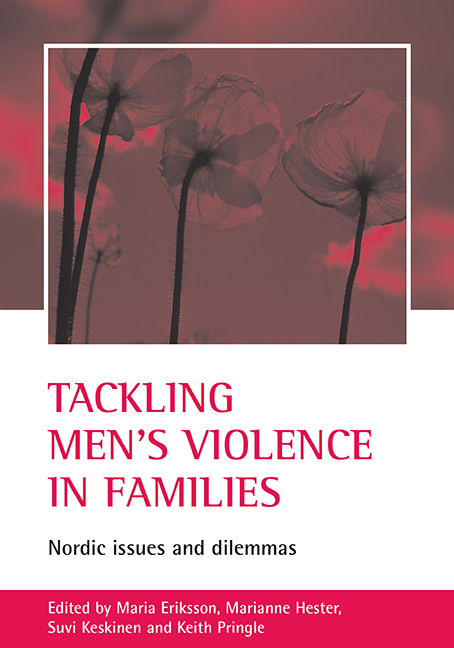Book contents
- Frontmatter
- Contents
- List of tables and figures
- Acknowledgements
- Notes on contributors
- one Introduction: Nordic issues and dilemmas
- two Children, abuse and parental contact in Denmark
- three Commitments and contradictions: linking violence, parenthood and professionalism
- four “Talking feels like you wouldn’t love Dad anymore”: children’s emotions, close relations and domestic violence
- five Bypassing the relationship between fatherhood and violence in Finnish policy and research
- six Marching on the spot? Dealing with violence against women in Norway
- seven Children’s peace? The possibility of protecting children by means of criminal law and family law
- eight A visible or invisible child? Professionals’ approaches to children whose father is violent towards their mother
- nine “Take my father away from home”: children growing up in the proximity of violence
- ten Neglected issues in Swedish child protection policy and practice: age, ethnicity and gender
- eleven Tackling men’s violence in families: lessons for the UK
- References
- Index
two - Children, abuse and parental contact in Denmark
Published online by Cambridge University Press: 20 January 2022
- Frontmatter
- Contents
- List of tables and figures
- Acknowledgements
- Notes on contributors
- one Introduction: Nordic issues and dilemmas
- two Children, abuse and parental contact in Denmark
- three Commitments and contradictions: linking violence, parenthood and professionalism
- four “Talking feels like you wouldn’t love Dad anymore”: children’s emotions, close relations and domestic violence
- five Bypassing the relationship between fatherhood and violence in Finnish policy and research
- six Marching on the spot? Dealing with violence against women in Norway
- seven Children’s peace? The possibility of protecting children by means of criminal law and family law
- eight A visible or invisible child? Professionals’ approaches to children whose father is violent towards their mother
- nine “Take my father away from home”: children growing up in the proximity of violence
- ten Neglected issues in Swedish child protection policy and practice: age, ethnicity and gender
- eleven Tackling men’s violence in families: lessons for the UK
- References
- Index
Summary
Since the 1980s, there has been a growing emphasis on the involvement of both biological parents in the care of their children post-separation and divorce in Europe, North America, Australia and New Zealand (see also Chapters Three, Five, Seven and Eight in this volume). This reflects article 9 of the UN Convention on the Rights of the Child, concerning children's right to know their two parents. The emphasis on involvement of both biological parents has involved shifts in family law to include a variety of joint parenting arrangements, for instance in the form of joint custody (in Denmark – 1985 Myndighedslov [Custody law] and 1995 Lov om Forældremyndighed og Samvær [law on Custody and Contact]), or shared parental responsibility (in England and Wales, the 1989 Children Act). It has also meant increasing emphasis on contact by non-residential parents with their children post-separation, as exemplified by the existence of a contact presumption.
The contact presumption has, however, been challenged in recent years as research has increasingly indicated that contact or access does not always or necessarily equate with the welfare or best interests of children. For instance, where there is a history of domestic violence, children may also have suffered harm, and both women and children may face ongoing violence and abuse from the abuser post-separation. In such circumstances, children may face continuing detriment and possible long-term harm if there is contact or access with the violent parent. These issues are beginning to be taken into account in judicial discourses and practice in the UK, New Zealand and elsewhere (Kaganas, 2000; Eriksson and Hester, 2001; Jaffe et al, 2003).
In Denmark, recognition of links between domestic violence and possible harm of children were implicit in professional practice and discourses related to custody and contact during the earlier part of the 1990s, and led to a safety-oriented ‘pragmatic’ approach with regard to child contact arrangements (Hester and Radford, 1992, 1996). The latter part of the 1990s, however, has seen a shift away from such a safety-oriented approach towards a much stronger emphasis on contact. Arguments favouring ‘equality’ between parents and recourse to outdated and misleading evidence concerning ‘father deprivation’ has underpinned an ideological or rights-based change in legislation and policy.
- Type
- Chapter
- Information
- Tackling Men's Violence in FamiliesNordic Issues and Dilemmas, pp. 13 - 30Publisher: Bristol University PressPrint publication year: 2005
- 1
- Cited by



